On October 14, 1968, the famously benign Switzerland initiated an unprovoked military attack on its diminutive neighbour, Liechtenstein.
The target was the Malbun ski resort, which was hit with five artillery shells in a dominant show of force. It would have been quite a shock for the largely defenceless European microstate, which occupies an area roughly a hundred square kilometres smaller than the regional Victorian city of Bendigo.
That is, if it hadn’t been for one thing. Switzerland, the larger aggressor both in terms of physical size and outright power, initiated the assault completely by accident, and apologised profusely.
Thankfully, the only casualties were a handful of outdoor dining chairs.
This, oddly enough, goes someway to explaining Ford’s accidentally hostile strategy with the Mach 1 Mustang.
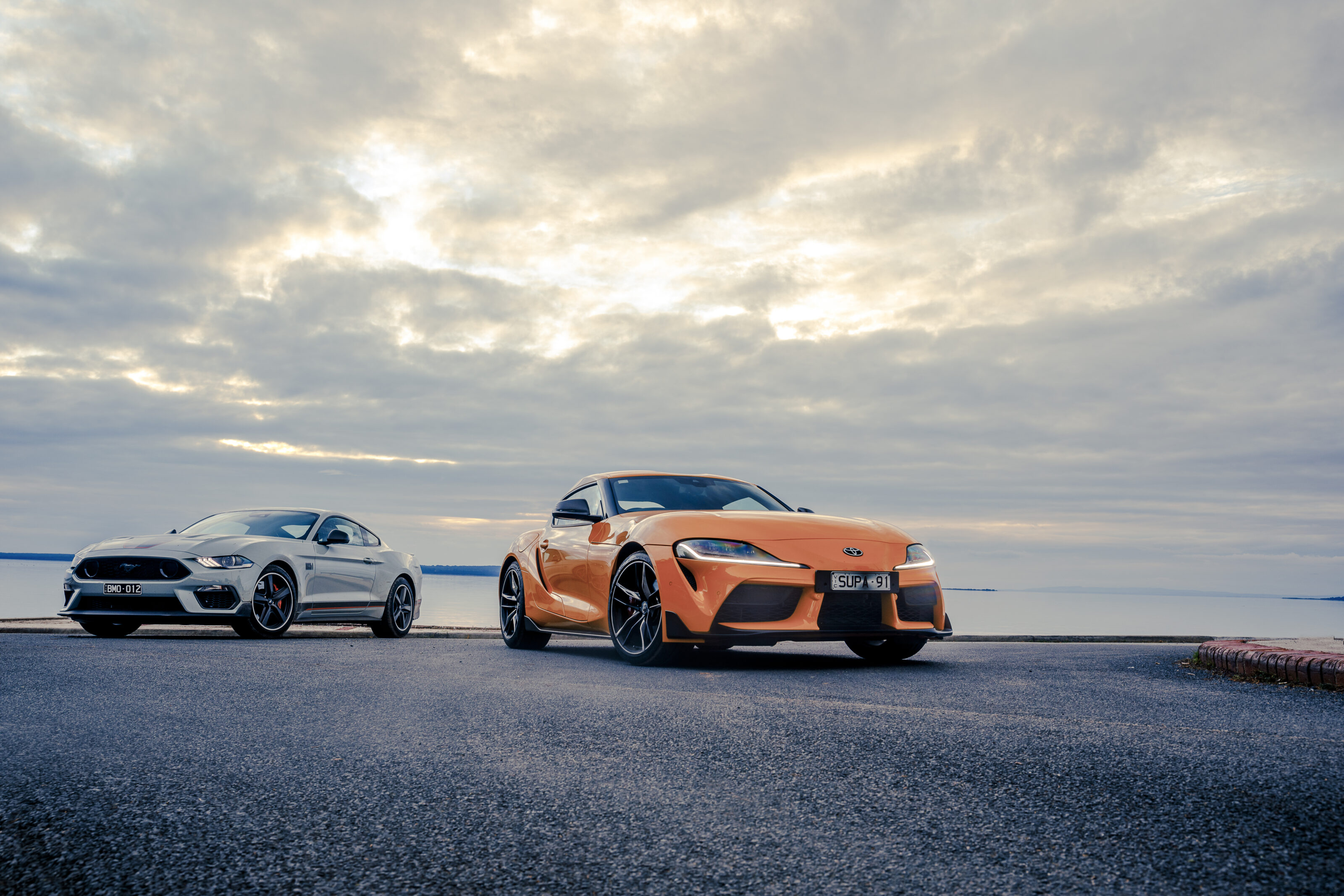
When the Ford Mustang first landed in Australia in 2016 the flagship 5.0-litre V8 powered GT cost a smidge less than $60K, making it a natural rival to the final Holden Commodore SS-V, and not much else. Its relative affordability paired with 306kW of naturally aspirated V8 power and iconic coupe styling made it a sales hit, and it’s easy to understand why.
Now five years later, in a perfect display of mission creep, the flagship Mach 1 Mustang costs more than $80,000, putting it in the same financial ballpark as cars it never intended to compete against on initial launch.
Ford has made small incremental bumps in performance and exclusivity to match the increased price, with 345kW now being deployed by the special-edition ’Stang (along with a raft of new go-fast mechanical additions), of which just 700 are coming Down Under.
The most important updates for the Mach 1 sit underneath its more aggressive bumper treatment and retro badging, with the induction system, intake manifold, oil cooler and 87mm throttle bodies lifted from the Shelby GT350. Initially the track-focused ’Stang was intended to be fitted with a Torsen limited-slip differential as standard, but the final specification ended up somewhat other than expected (see bottom).
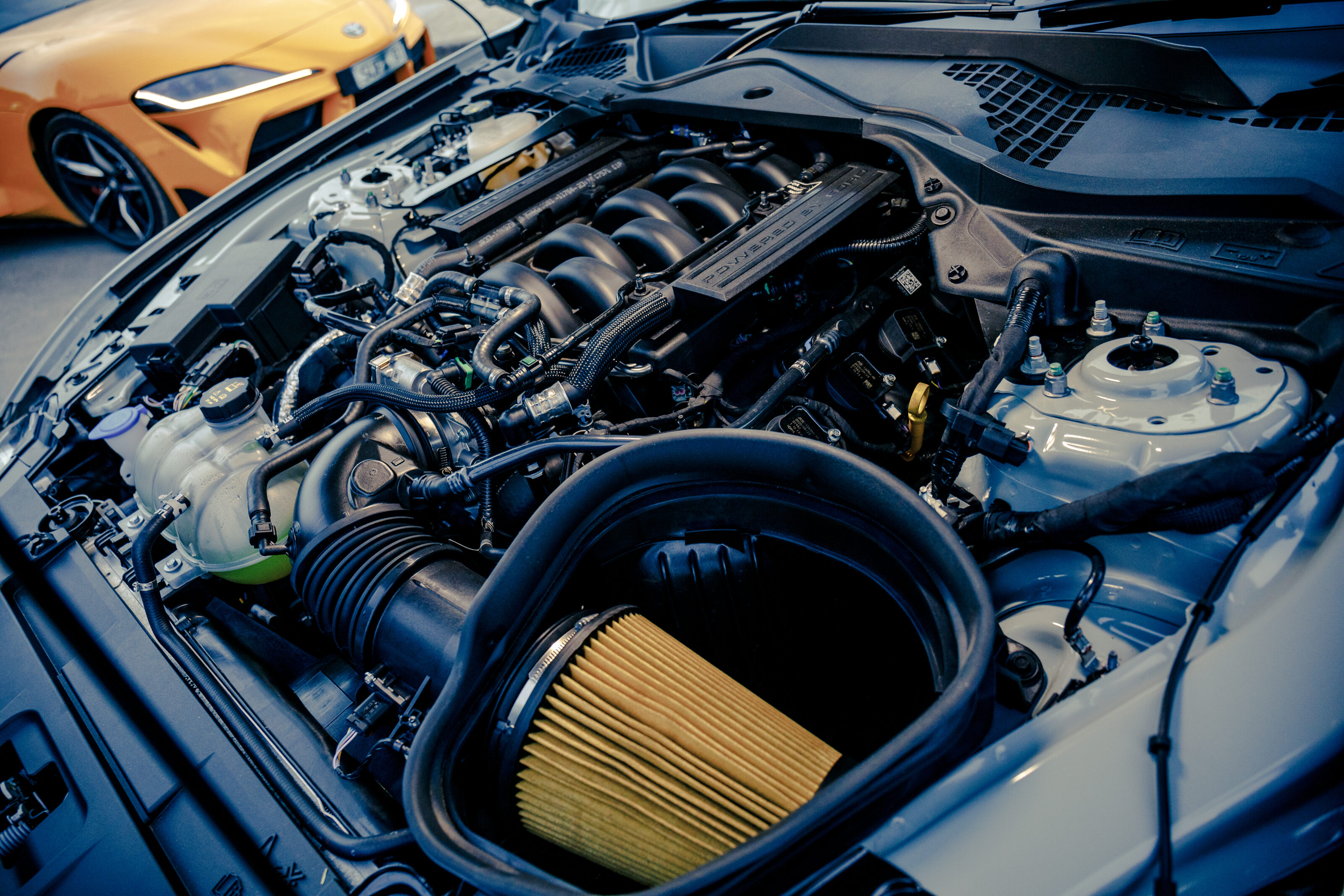
“The Mustang is now in the same realm as cars it was never meant to compete against”
All right-hand drive Mach 1s are instead fitted with Ford’s own mechanical limited-slip differential instead of the Torsen unit, which is identical to that found in the Bullitt and GT Mustangs.
Despite the change Ford says the Mach 1’s diff is still fitted with the requisite cooler to ensure performance remains unchanged. Scott Newman’s track test in MOTOR’s May issue, and our day of hard driving for this comparison, would indicate that customers are at no great loss because of the swap.
Despite the noble intent of these upgrades, Ford has. perhaps inadvertently, found itself marching with a heavy foot into the territory of a car that speaks more quietly yet carries a very big stick – the Toyota Supra. It’s only fair then that we bring the pair together to see if Dearborn’s hero can hold its own against the pride of Japan, or Graz if we’re being accurate.
The Toyota is smaller, less powerful, and more expensive than the Mustang, but wears a badge of honour from narrowly vanquishing the Mercedes-AMG A45 S in a previous comparison test. Game on.
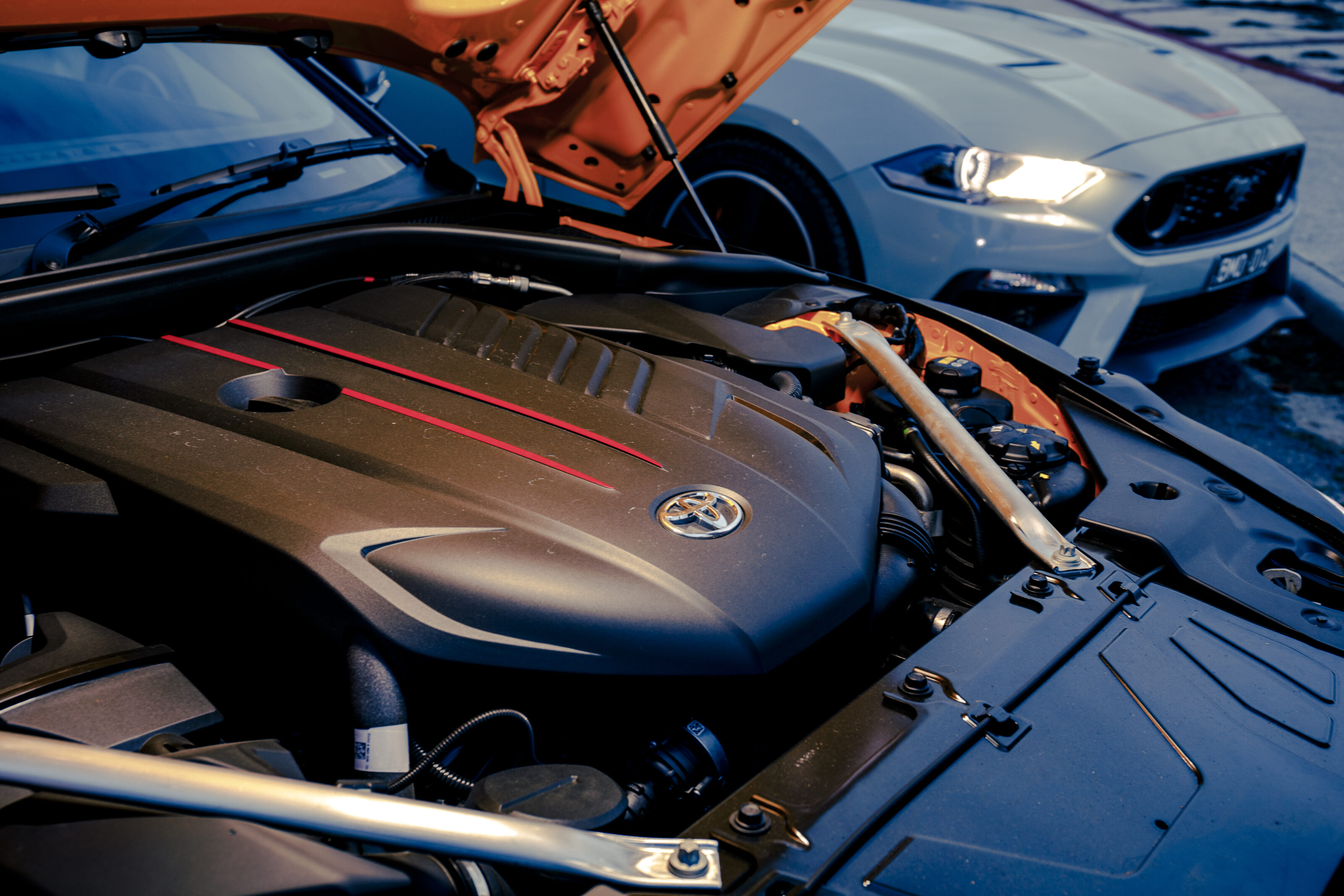
Both cars are exclusively rear-driven and utilise torque converter automatics (10 ratios in the Ford and eight in the Toyota). The variant we have here is the full-fat Supra GTS, but as we’ve noted before, the entry-level GT offers exactly the same performance credentials with 10 grand slashed from the price tag, which is only a couple of thousand dollars more compared to the Mach 1.
These cars fight in different weight classes. The Mach 1 is carrying an extra 284kg of heft, which you can’t escape behind the wheel. It’s also 410mm longer, with an extra 250mm between the axles. Interestingly, the Supra has the wider front-track of the two. You get a larger cabin and rear seats in the Mustang because of the physical differences, but the extra size and weight play against it dynamically, and the back seats are practically useless.
When it comes to firepower, the Mustang has the edge, with its naturally aspirated 5.0-litre V8 producing 345kW and 556Nm. The Supra uses a BMW-sourced 3.0-litre turbocharged inline-six cylinder, which now produces 285kW and 500Nm after a power bump late last year.
Where the previous 250kW example would only reach peak power at 7800rpm, the updated Supra gives you 285kW from 5800-6500rpm, while the peak torque figure remains unchanged but is spread across a larger window of 1800rpm-5000rpm (previously 1600-4500rpm).
Lined up for performance testing, the Supra and Mustang both struggle for traction. However, it’s the Toyota which manages better off-the line, and between 10-60km/h it ekes out a circa four-tenth advantage that it never relinquishes. The key difference is the length it takes for the Mustang to recover from flares of wheelspin at low speeds.
Identical 80-120km/h times are a testament to the evenly matched performance. Both coupes are four-tenths behind their claimed 0-100km/h sprint times on a cold and intermittently drizzly day but hard acceleration in each presses your head back into the seat and requires your full attention as they chirp the tyres between shifts.
BMW’s B58 engine has a vast powerband which the Supra deploys at will. With peak torque and power now available more readily, the Supra feels eager to launch toward the next bend the moment you start to apply more throttle. The power delivery feels well judged for fast road driving. Drive the Supra on a winding back road and you won’t feel short-changed or be left wanting for more.
The Coyote V8 is a peach of an engine that is happy to rev hard. If you are used to thinking of V8s as primitive, cumbersome, iron-block anchors, this 5.0-litre is a complete subversion of the stereotype. However, access to the best it has to offer is oddly hidden away.
This is due to a number of factors; primarily a surprisingly long throttle pedal – you can find yourself thinking you are at max attack only to discover there is another inch of travel remaining. When you finally break the mental barrier and keep your foot pressed firmly to the firewall, it’s not until the final thousand revolutions that peak power comes on tap.
The result of this issue is that unless you have your eyes glued to the tacho you can be plucking another ratio circa 1500rpm before the 7500rpm redline to avoid colliding with the soft-cut limiter. Ford’s decision to give the Mustang a mile of throttle travel seems even stranger when you consider the high brake pedal. While it works fine for heel and toe, merely transitioning from throttle to brake without bothering the shifter means you can easily slide your foot into the side of, instead of onto the top of, the second pedal.
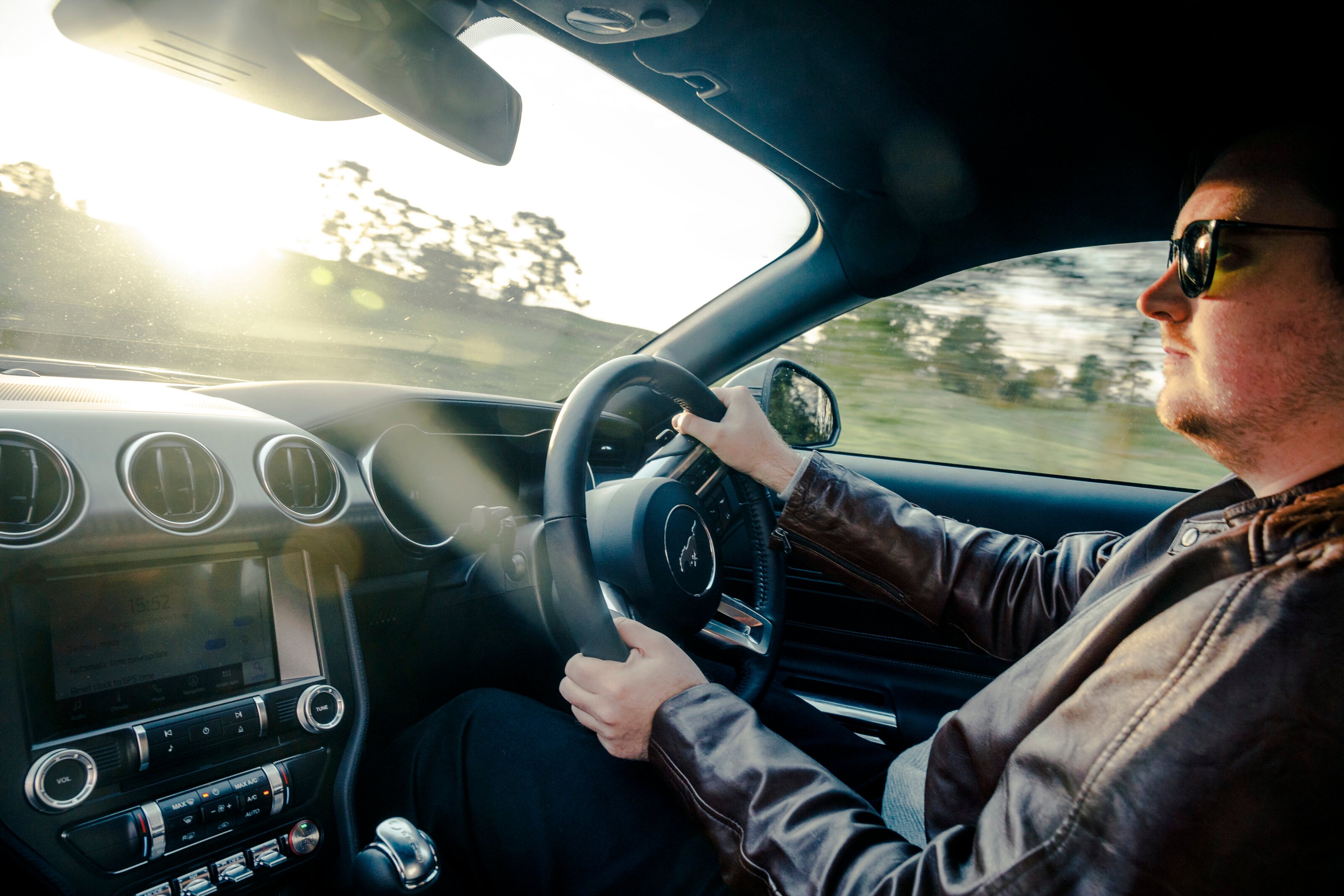
Once you adapt to the Mustang’s quirks it becomes apparent that this is a sports car worthy of its new found tax bracket. It is a fast car, and thankfully the Brembo brake system has impressive bite once you push through the initial hesitance at the top of the pedal’s arc.
The suspension has a softer demeanour with a level of body control that seems slackened very slightly to provide more pronounced pitch and roll. This small level of extra movement compensates in terms of communication for the steering, which can most generously be described as vague. It has a level of numbness that blankets all your inputs, and the returning feedback is muted.
Part of this can be attributed to the slower steering rack (2.5 turns lock-to-lock compared to the Supra’s 2.0), but it also provides little in the way of positive communication. In this area the Toyota has so much more finesse that it’s a clear class above.
Because of the steering you have to work at the Mach 1 to access the best of its dynamic abilities. While the muted front-end and extra weight compared to the Toyota are ever present, the Mustang remains an absolute laugh when you grab it by the scruff of the neck – it is a joyous experience for those wanting something that doesn’t take itself quite so seriously. This is accentuated by the soundtrack, which is classic hits rock’n’roll V8 roar with the amps turned to 11.

Even in its ‘Normal’ exhaust setting the Mustang is shockingly loud. In direct contrast the Supra’s exhaust is comparatively muted. Sure it’ll pop and bang here or there, but it seems almost half-hearted compared to the bombastic antics of the ’Stang.
Want every drive to feel like an event? The Mustang is the car for you. The Mustang’s shortcomings are difficult to establish until you put it against a car as focused and well-prepared as the Supra. If you don’t test drive another vehicle, you’ll be none the wiser, and can easily and understandably fall for the Mach 1’s charms.
It must be said that the V8 engine and its associated theatre in the Mustang attracts buyers of its own right. While Toyota can’t match Ford on an emotional level, it makes a compelling logical case. If you completely disregard the Supra on the basis of its cylinder count alone you are walking away from one of the finest driving experiences for less than $100K, and it might be time to re-evaluate your priorities.
Driving the Supra quickly is a more engaging experience compared to the Mustang, with information transferred from the road to your extremities clearly and concisely. You know exactly what is going on with the front wheels at all times, with the intimate and instant connection between driver and car aided by the small cabin and slender steering wheel.
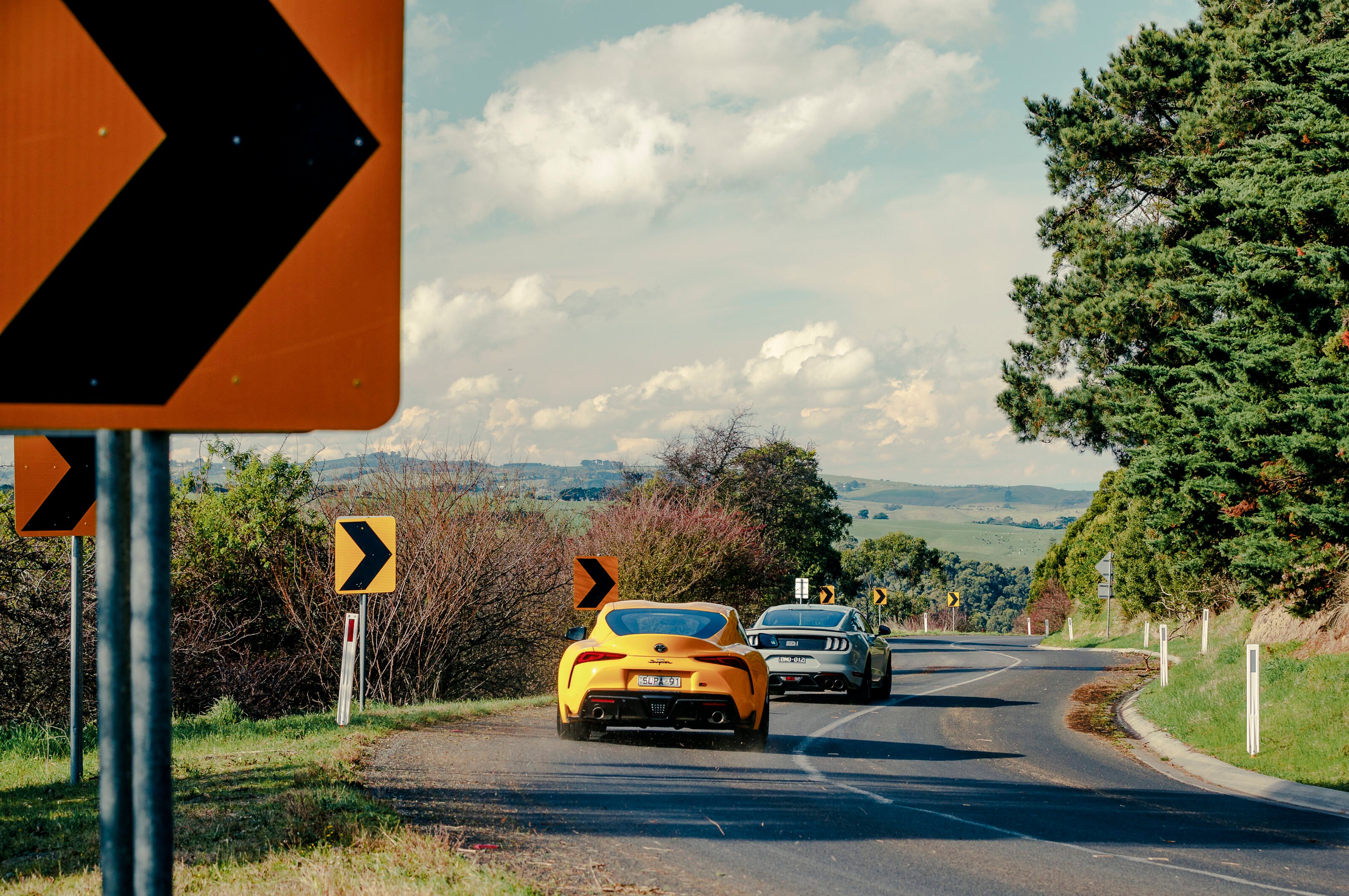
Where the Mustang has a big, chunky feel to everything it does, the Supra has greater poise, is lighter on its feet, and incredibly agile. Toyota has pulled a rabbit out of the bag with the steering.
It is light and delicate, yet has plenty of feedback which is communicated with fine levels of fidelity. It is truly a delight. Put simply, it is a faster, crisper, purer experience. But sometimes you don’t want pure. Sometimes you want to feel like a hero – which is exactly where the Mustang steps in with all its bravado.
Despite its BMW origins, the Supra still has all some key hallmarks of a Toyota, for better or worse. Namely the ESC setting, which is typical Toyota in its early interventions. That’s a shame, because when you loosen the nannies, you realise the Supra has a wonderfully neutral chassis balance and is progressive and communicative in the way it relinquishes grip, allowing you to compensate appropriately.
Understand its limits and the Supra will engage and interact as a very willing participant, where the Mustang always feels like you have taken it out of its comfort zone. That brutish muscle car character is ever present compared to the Supra’s refined and polished sports coupe credentials.

To its credit, where the Mach 1 is comfortable is a wider window of operation than that offered by the Supra. You could easily use the Mustang as a grand tourer on long drives where doing the same in the Toyota would only be understandable if your end destination is an insane asylum with the smaller physical size and persistent road noise eradicating any long distance driving credentials it may hope to possess.
The Supra’s cabin, which feels shrink wrapped around you, is great on a twisting road, but when the world opens up and you want space to breathe, the Mach 1 is the only viable option.
While Australians miss out on the full-fat GT350R and GT500 Mustangs, the Mach 1 is essentially a Shelby-lite and all the better for it. This is the best performing enthusiast-focused Mustang ever offered for sale in Australia.
Where the R-Spec had the feel of a wicked-up hot rod, the Mach 1 is a more holistic sports car. Both in terms of price and performance it justifies its existence in a way that puts a mile-wide grin on your face. For those wanting an experience when driving, the Mach 1 gives you that at every turn. It’s an elbows out arrival into hostile waters from Ford Performance.
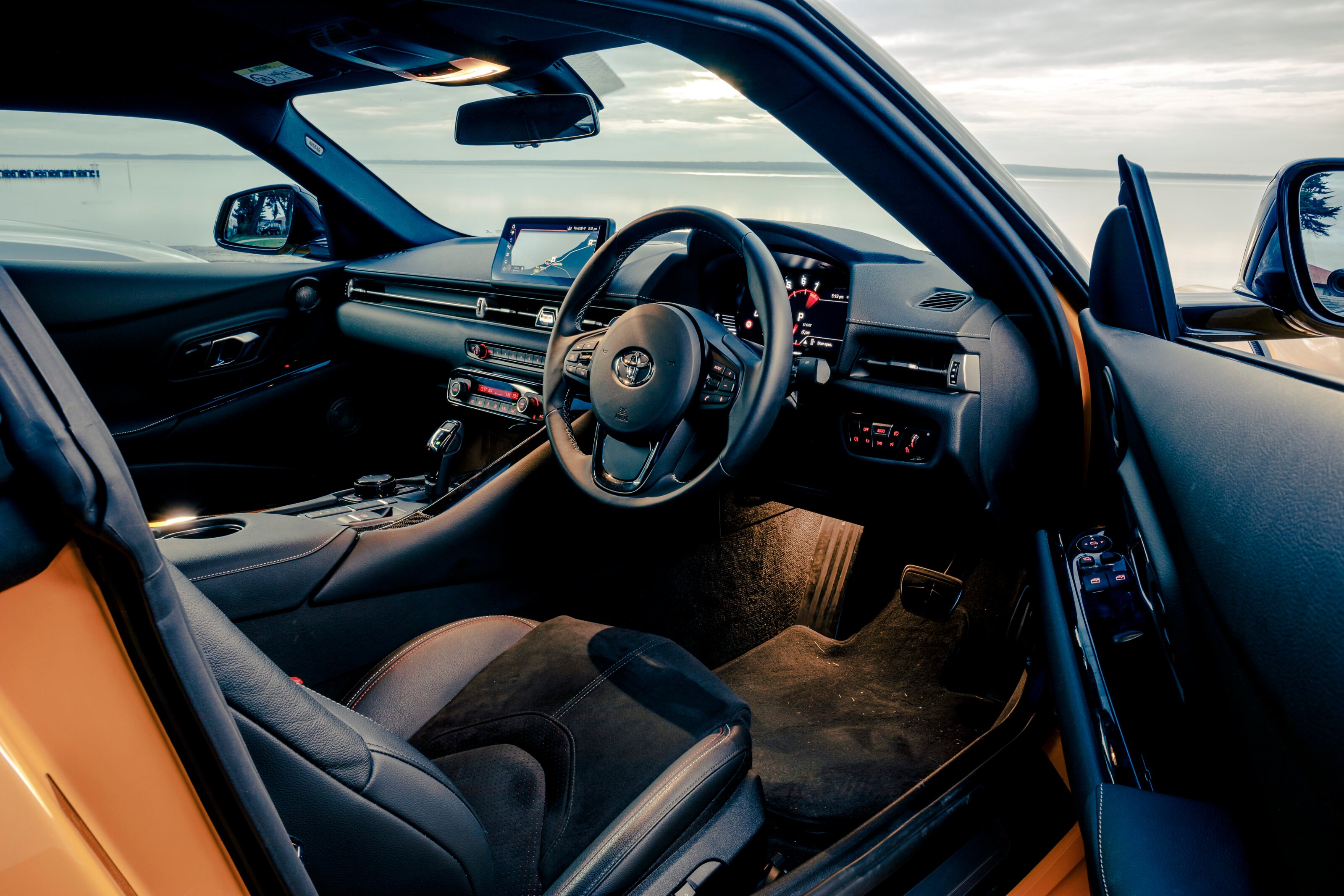
Despite costing more and providing less power, the Supra bobs and weaves beyond the Mach 1’s reach. It’s sharp, tactile, and is one of the best drivers’ cars you can buy at this price point. From inception to execution Toyota has been clear with the Supra’s intent, achieving it brilliantly.
Driving the Supra after the Mustang is akin to going from a bass-heavy Beats Bluetooth speaker to a full set of Naim hi-fi separates. The finer levels of fidelity gives you greater clarity and a purer experience behind the wheel.
But the fact the Supra outperforms the Mustang points to an interesting historical shift that is at play with these two cars. Both Ford and Toyota have transitioned them away from the true spirits of their ancestors, closer toward what the collective zeitgeist has decided each should represent.
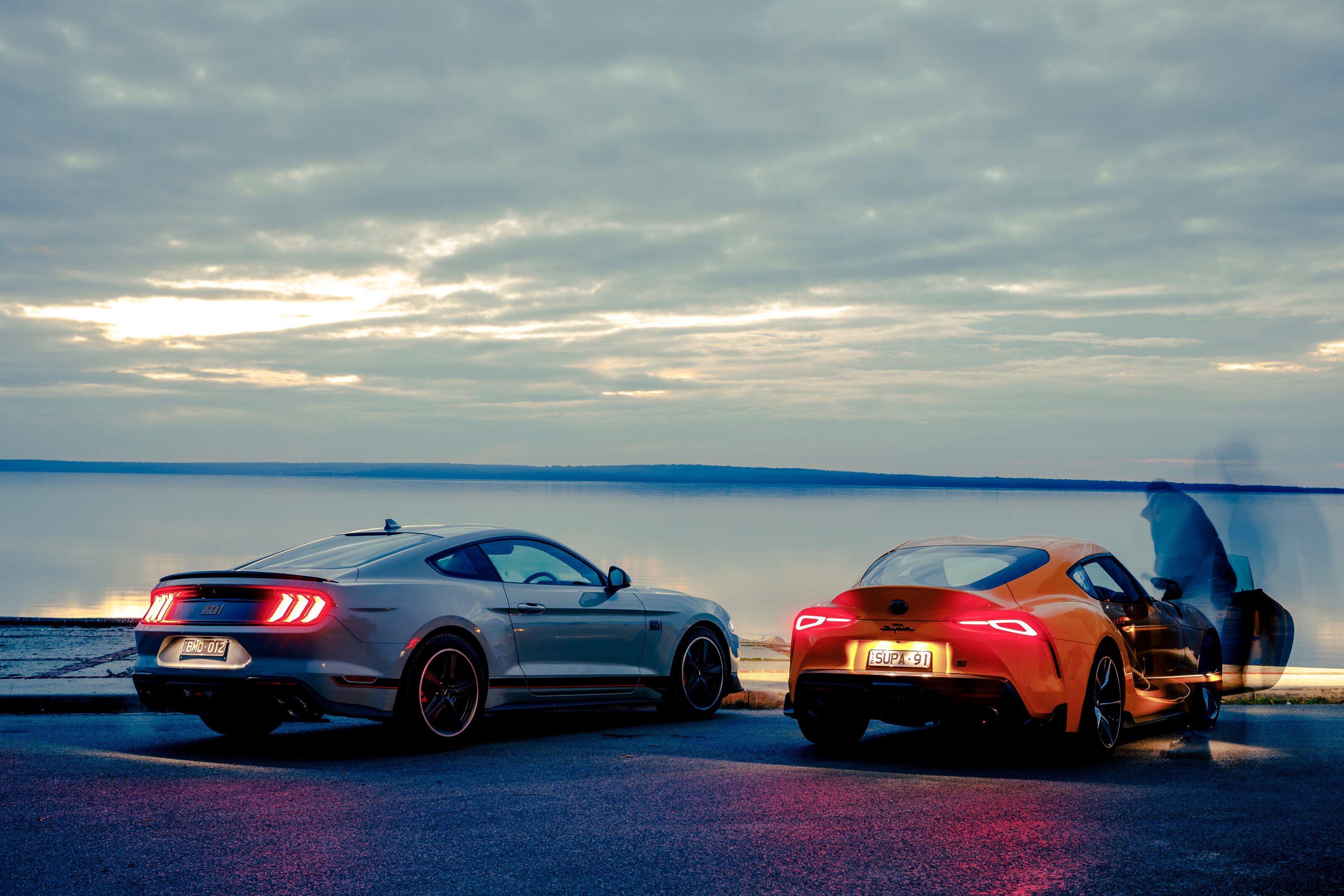
Where the original Mustang of the ’60s was a lighter, smaller, nimbler counterpart to the swaggering muscle cars Detroit was building en masse, this modern interpretation has a distinct brutish flavour because that’s what buyers now expect of it.
Similarly, the MkIV Supra was more grand tourer than sporting scalpel, but pop culture phenomena like The Fast and the Furious and Gran Turismo transformed that perception in its entirety. The MkV is as focused as it is partly due to its Germanic links, but mostly because The People demanded it. Perception has become reality.
Where the Ford stumbled into its place in the sports car hierarchy and has performed a clever remedial job in justifying its newfound status, the Toyota was brought into the world riding on the coat tails of BMW’s dynamic excellence, comfortable with its end goal and effortlessly assuming its new sporting mantle.
Following its first salvo in ’68, Switzerland would ‘invade’ Liechtenstein a further five times. Ford may have lost the first battle, but with a new generation of Mustang looming in the distance, we suspect this isn’t the end of the Blue Oval’s accidental performance car war.

Spec Ops
In the time between the Mach 1 being announced for Australia, and finally arriving, several features had been removed from the physical cars, but not promotional materials – namely the Torsen limited-slip diff, adaptive cruise control, and audible parking sensors. To say sorry, Ford is giving Mach 1 owners a free track day and servicing.
For buyers in the market for a Supra there are just two variants on offer. If you opt for the Supra GTS over its cheaper GT sibling you gain 19-inch wheels (up from 18 inches), wrapped in the same Michelin Pilot Super Sport tyres as the GT, larger rear brakes with red calipers, metal pedals, a head-up display, JBL sound system, and the ability to option Alcantara interior trim and matte grey paint at $2500 a pop. The extra features will set you back 10 stacks and you don’t even get a free day at the track.
Ford Mustang Mach 1 specs
| Body: | 2-door, 4-seat coupe |
|---|---|
| Drive: | rear-wheel |
| Engine: | 5038cc V8, DOHC, 32v |
| Bore x Stroke: | 93 x 92.7mm |
| Compression: | 12.0:1 |
| Power: | 345kW @ 7000rpm |
| Torque: | 556Nm @ 4600rpm |
| Power/Weight: | 194kW/tonne |
| Transmission: | 10-speed automatic |
| Weight: | 1779kgu00a0 |
| Suspension: | struts, coil springs, adaptive dampers, anti-roll bar (f); multi-links, coil springs, adaptive dampers, anti-roll bar (r) |
| L/W/H: | 4789/1916/1387mm |
| Wheelbase: | 2720mm |
| Tracks: | 1585/1654mm (f/r) |
| Steering: | electrically assisted rack-and-pinion |
| Brakes: | 380mm ventilated discs, 6-piston calipers (f); 330mm ventilated discs, single-piston calipers (r) |
| Wheels: | 19 x 9.5-inch (f); 19 x 10.0-inch (r) |
| Tyres: | 255/40 R19 (f); 275/40 R19 (r) Michelin Pilot Sport 4 S |
| Price: | $83,365 |
| Pros: | Raucous soundtrack; larger than life character; last of the atmo V8s? |
| Cons: | Lack of steering feel; high seating position; canu2019t hide extra weight; odd pedal placement |
| Star Rating: | 4/5 |
Toyota Supra GTS specs
| Body: | 2-door, 2-seat coupe |
|---|---|
| Drive: | rear-wheelu00a0 |
| Engine: | 2998cc inline-6, DOHC, 24v, turbocharged |
| Bore x Stroke: | 82 x 94.6mm |
| Compression: | 11.0:1 |
| Power: | 285kW @ 5800-6500rpm |
| Torque: | 500Nm @ 1800-5000rpm |
| Power/Weight: | 190kW/tonne |
| Transmission: | 8-speed automatic |
| Weight: | 1495kg |
| Suspension: | struts, adaptive dampers, coils, anti-roll bar (f); multi-links, adaptive dampers, coils, anti-roll bar (r) |
| L/W/H: | 4379/1854/1292mm |
| Wheelbase: | 2470mm |
| Tracks: | 1594/1589mm (f/r) |
| Steering: | electrically assisted rack-and-pinion |
| Brakes: | 348mm ventilated discs, 4-piston calipers (f); 345mm ventilated discs, single-piston calipers (r) |
| Wheels: | 19 x 9.0-inch (f); 19 x 10.0-inch (r) |
| Tyres: | 255/35 ZR19 (f); 275/35 ZR19 (r) Michelin Pilot Super Sport |
| Price: | $97,126 |
| Pros: | Useable performance; overall chassis balance; agile handling |
| Cons: | Small cabin; intrusive road noise; muted exhaust sound |
| Star Rating: | Star Rating: 4.5/5 |





